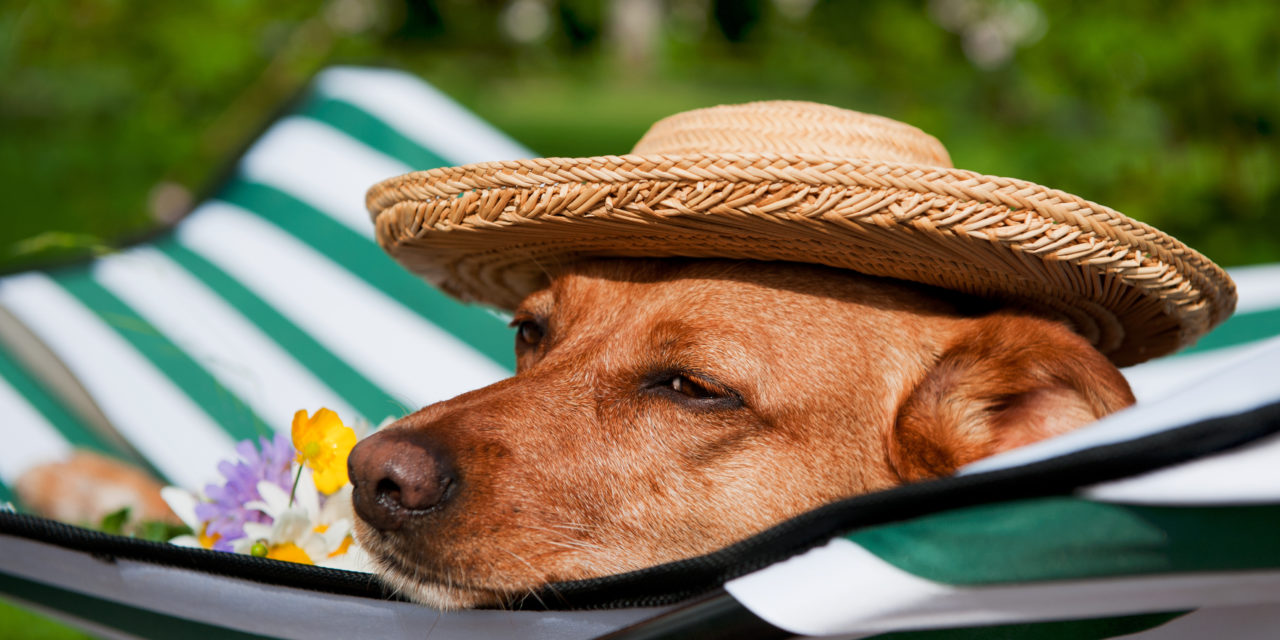 The dog days of summer are here and it is important to take extra care of man’s best friend during the heat! While some breeds that originate in warmer climates may have a greater tolerance for the heat, all dog owners need to keep all pets cool and watch out for signs of dehydration and heatstroke during the summer.
The dog days of summer are here and it is important to take extra care of man’s best friend during the heat! While some breeds that originate in warmer climates may have a greater tolerance for the heat, all dog owners need to keep all pets cool and watch out for signs of dehydration and heatstroke during the summer.
Negligence can lead to heatstroke, dehydration, other serious health problems, and even death. If you believe that your dog has heatstroke or is dehydrated try to get your dog in a cool place and call your veterinarian immediately.
The signs of heatstroke include:
- Temperature over 101
- Constant panting and labored breathing
- Tremors
- An excess production of saliva that is thickened
- Staggering
- Fatigue
- Depression or dog does not seem like usual self
The symptoms of dehydration include:
- Sunken eyes
- Depression or dog does not seem like usual self
- Lethargy
- Dry mouth
- Take a fold of skin at the top of their neck and gently pinch it and release it. If it is slow to return back to normal or stands in place, this could be dehydration
 Here are some tips from on how to keep your pet cool this summer:
Here are some tips from on how to keep your pet cool this summer:
- Never leave a dog parked in a car. In a matter of minutes, temperatures can rise to a dangerous point for your pet, seriously injuring or even killing them. A study from Dogster showed that in ten minutes, if the temperature is 85 outside, the temperature inside a vehicle can reach 104. Many states are making it illegal to leave pets unattended in hot cars. If found guilty the penalties could be several fines to a risk of jail time.
- Make sure that your pet has fresh water at all times. Add ice cubes for an extra chilly treat.
- If you are outside make sure that your dog has access to shelter from the sun.
- Try a cooling mat, ice pack, or frozen towel for your pet to lay on.
- For a fun playtime activity, take a baby pool and fill it with shallow, cool water and toys.
- Avoid taking walks when the sun’s rays are the strongest. Try going early morning or evening. Make sure that your dog is visible with a reflective vest or collar.
- If your dog has to be outside in the sun, try to avoid pavement. This could quickly burn the pads of the feet and use booties to insulate their feet or make your own dog wax. You may want to consider using a pet-friendly sunscreen to protect your dog from UV rays too.
- For an ultimate cool treat, make frozen pupsicles!
Burt’s Paw Wax and Miracle Ointment:
- Pure 100% Natural Beeswax (food grade)
- Organic Coconut Oil (food grade)
- Oilve Oil
Well grease a small saucepan or double broiler and heat it on the stove to a medium temperature. The beeswax is easier to melt in smaller cubes. You can buy pre-cubed beeswax, or you can cut this yourself using a hot knife or a chisel depending on the consistency of the wax. This recipe calls for equal parts beeswax and coconut oil. Add your beeswax to the pan and continually stir to ensure that you do not burn it. While stirring, add in the coconut oil and 1 tablespoon of
olive oil. Stir until the mixture is smooth and all lumps have disappeared. The mixture can be poured into a glass or tin container, or a lip balm tube. Wait till they have completely cooled and cap. This should last for 1-2 years and are perfect year round.
You should apply to the pads of your dog’s feet before they go on hot pavement or sand. The wax acts as an extra layer of protection to keep the skin from burning. This product can also be used during the winter to protect their feet from snow, ice, and de-icing products. In addition to a paw protector, it works as a nose lotion. Many dog breeds are prone to rough, dry, and cracked noses that can often be painful. This wax can be applied every day to help soothe the nose and eventually heal over time. It is important to buy food grade products, so if they lick it off they won’t get sick. It is not advised that they eat it. I have several tins of this wax on hand in the case of any injury. A year and a half ago, I was talking one of my dogs, Burt for a walk and he got attacked by a German shepherd. He had deep wounds by his eye and on his nose. The veterinarian said there wasn’t anything I could put on it other than to wash it with soap and water daily. They thought the hair and skin would probably never grow back and he would be left with some major scarring. I decided to do some research, headed to the kitchen, and came up with this recipe. I applied the ointment 5 or 6 times a day and 1.5 years later, most of the skin has healed, hair has grown back, and you can barely tell he has any scars! This is a great all-purpose wax that is safe to use on humans too.

 Dog Pupsicles:
Dog Pupsicles:
- Galvanized Pail
- Water
- Beef or Chicken Broth
- Dog Treats
- Dog Toys
I have 3 golden retrievers with thick coats who have a hard time keeping cool in the summer. I picked up  several galvanized pails from Buchheit to make the popsicle molds. They had an assortment of sizes and found that that 3-pint was perfect for one large dog. I greased the pail with food grade coconut oil and picked out 4 rubber dog toys to put in the pail. I added a small variety of dog treats that I had picked up from Buchheit and filled the pail ¾ full with water. I added 2-3 tablespoons of beef broth and stirred the concoction. Since this was a larger pail, I let this sit in my freezer for several days. For smaller dogs, you can take water, treats, and broth and add it in an ice cube tray and freeze. Run hot water over the outside of the pail and it should slide out. My dogs had fun for several hours biting, licking, and clawing the popsicle. It was the perfect way for them to cool down on a hot summer’s day!
several galvanized pails from Buchheit to make the popsicle molds. They had an assortment of sizes and found that that 3-pint was perfect for one large dog. I greased the pail with food grade coconut oil and picked out 4 rubber dog toys to put in the pail. I added a small variety of dog treats that I had picked up from Buchheit and filled the pail ¾ full with water. I added 2-3 tablespoons of beef broth and stirred the concoction. Since this was a larger pail, I let this sit in my freezer for several days. For smaller dogs, you can take water, treats, and broth and add it in an ice cube tray and freeze. Run hot water over the outside of the pail and it should slide out. My dogs had fun for several hours biting, licking, and clawing the popsicle. It was the perfect way for them to cool down on a hot summer’s day!







